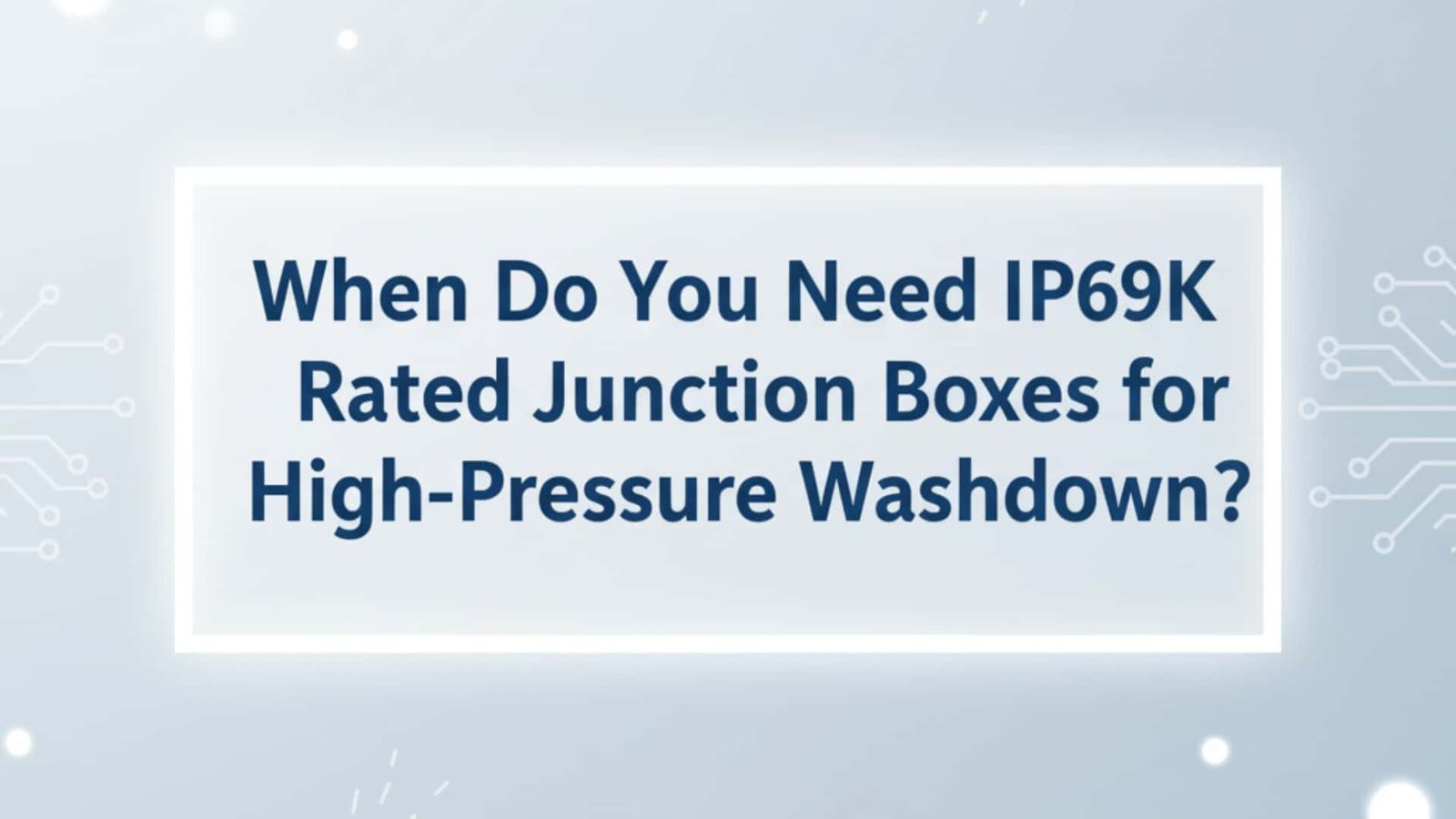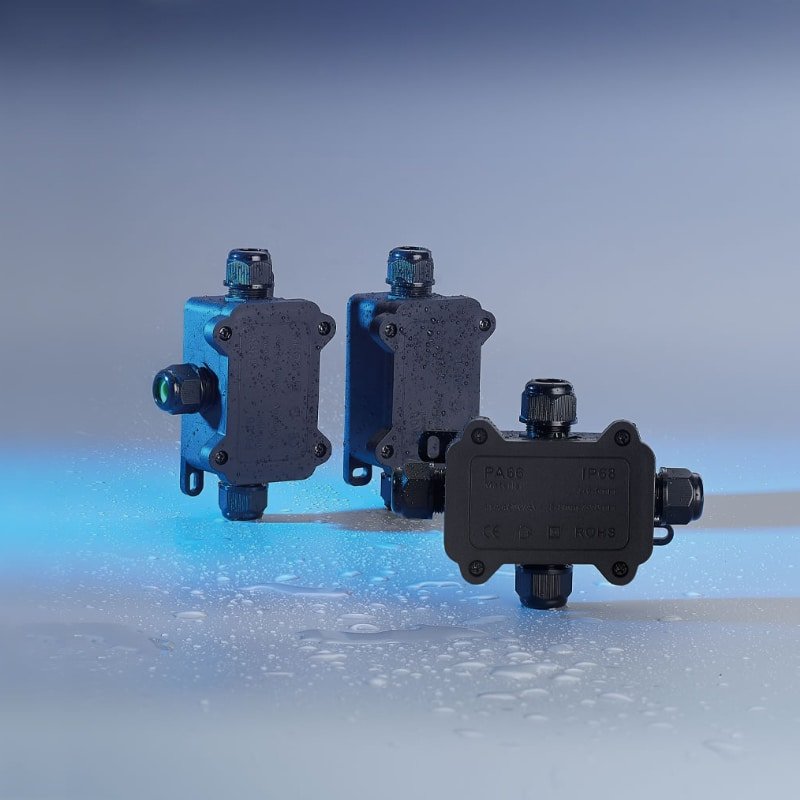When Thomas, the facility manager at a major poultry processing plant in Arkansas, watched his “waterproof” IP65 junction boxes fail spectacularly during their first high-pressure sanitization cycle, he realized he’d made a $75,000 mistake. Hot water at 80°C and 100 bar pressure had penetrated every seal, causing equipment failures and a three-day production shutdown during peak season.
IP69K rated junction boxes1 are essential for applications involving high-pressure, high-temperature washdown procedures common in food processing, pharmaceutical manufacturing, and chemical industries. These enclosures must withstand water jets at 80-100 bar pressure and temperatures up to 80°C while maintaining complete electrical protection.
This isn’t just about being “extra waterproof” – IP69K represents the highest level of protection against water ingress, specifically designed for the most demanding washdown environments. In my experience at Bepto Connector, I’ve seen how the wrong IP rating can shut down entire production lines and create serious safety hazards. Let me guide you through when and how to specify IP69K protection correctly.
Table of Contents
- What Exactly Does IP69K Protection Mean?
- Which Industries and Applications Require IP69K?
- How Do You Select the Right IP69K Junction Box?
- What Are the Installation and Maintenance Requirements?
- FAQs About IP69K Rated Junction Boxes
What Exactly Does IP69K Protection Mean?
IP69K represents the ultimate protection against high-pressure, high-temperature water ingress. Understanding the specific test requirements helps you determine if this level of protection is necessary for your application.

IP69K Test Parameters
The “K” Designation:
The “K” in IP69K indicates compliance with DIN 40050-9 standard2, specifically designed for road vehicles but adopted across industries requiring extreme washdown protection.
Test Conditions (Per DIN 40050-9):
- Water Pressure: 80-100 bar (1160-1450 psi)
- Water Temperature: 80°C ± 5°C (176°F)
- Nozzle Distance: 100-150mm from enclosure surface
- Spray Angle: 0°, 30°, 60°, and 90° to all surfaces
- Test Duration: 30 seconds per angle, per surface
- Flow Rate: 14-16 liters per minute
Pass Criteria:
- Zero water ingress detectable inside enclosure
- All electrical functions must remain operational
- No permanent deformation or damage to sealing systems
Comparison with Other IP Ratings
Understanding the progression helps clarify when IP69K is necessary:
| IP Rating | Dust Protection | Water Protection | Typical Application |
|---|---|---|---|
| IP65 | Dust-tight | Water jets (6.3mm nozzle, 12.5L/min) | General industrial |
| IP66 | Dust-tight | Powerful water jets (12.5mm nozzle, 100L/min) | Marine, outdoor |
| IP67 | Dust-tight | Temporary immersion (1m, 30 min) | Flood-prone areas |
| IP68 | Dust-tight | Continuous immersion | Underwater applications |
| IP69K | Dust-tight | High-pressure hot water jets | Washdown environments |
Critical Difference: IP69K specifically addresses high-pressure, high-temperature spray cleaning that can penetrate seals that would resist lower-pressure water or immersion.
Technical Requirements for IP69K Compliance
Sealing System Design:
- Multiple Seal Barriers: Primary and secondary sealing systems
- High-Temperature Elastomers: EPDM, FKM, or silicone seals rated for 80°C+
- Compression Sealing: Positive compression maintained under pressure differential
- Drain Systems: Internal drainage channels to redirect any minimal ingress
Housing Construction:
- Material Selection: Stainless steel 316L or high-grade thermoplastics
- Wall Thickness: Minimum 3mm for plastic, 2mm for stainless steel
- Reinforcement: Internal ribbing to prevent deflection under pressure
- Surface Finish: Smooth surfaces to prevent cleaning solution retention
Cable Entry Systems:
This is where Bepto’s expertise becomes critical! Standard cable glands fail under IP69K conditions:
IP69K Cable Gland Requirements:
- Dual Sealing: Both cable jacket and individual conductor sealing
- High-Temperature Materials: Seals rated for continuous 80°C operation
- Pressure Resistance: Withstand 100 bar without seal extrusion
- Chemical Compatibility: Resist cleaning chemicals and sanitizers
Which Industries and Applications Require IP69K?
IP69K protection is essential in industries where high-pressure, high-temperature cleaning is mandatory for hygiene, safety, or regulatory compliance. Understanding these applications helps justify the investment in premium protection.

Food and Beverage Processing
Mandatory Applications:
- Meat Processing: USDA requires high-pressure sanitization between production runs
- Dairy Operations: CIP (Clean-in-Place) systems operate at 80°C and high pressure
- Beverage Production: Sterile environments demand aggressive cleaning protocols
- Bakery Operations: Flour dust and high-temperature washdown create dual challenges
Regulatory Drivers:
- HACCP Compliance3: Hazard Analysis Critical Control Points require thorough cleaning
- FDA Regulations4: 21 CFR Part 110 mandates equipment cleanability
- USDA Guidelines: FSIS requires specific cleaning and sanitization procedures
- BRC Standards: British Retail Consortium demands washdown-resistant equipment
Case Study: A major cheese processing facility in Wisconsin upgraded to IP69K junction boxes after repeated failures during CIP cycles. The $200,000 investment eliminated 15+ annual failure incidents and reduced cleaning time by 30% due to improved equipment reliability.
Pharmaceutical Manufacturing
Critical Applications:
- Sterile Manufacturing: USP 797 requirements for sterile compounding areas
- API Production: Active pharmaceutical ingredient processing with solvent exposure
- Tablet Manufacturing: Dust control and cleaning validation requirements
- Packaging Areas: High-hygiene zones with frequent washdown cycles
Unique Requirements:
- Validation Documentation: Complete cleaning validation with IP69K equipment
- Material Traceability: FDA-compliant materials with full documentation
- Change Control: Validated cleaning procedures require equipment consistency
- Audit Compliance: Regular FDA and international regulatory inspections
Chemical and Petrochemical Industries
Demanding Environments:
- Chemical Processing: Aggressive cleaning solvents and high-pressure decontamination
- Refineries: Hydrocarbon removal and safety washdown procedures
- Specialty Chemicals: Batch processing with equipment changeover cleaning
- Paint and Coatings: Solvent-based cleaning and color change procedures
Safety Considerations:
- Hazardous Area Classification: IP69K equipment in Class I, Division 1 locations
- Emergency Decontamination: Rapid response cleaning for chemical spills
- Personnel Safety: Preventing electrical hazards during emergency washdown
- Environmental Compliance: Preventing contamination during cleaning operations
Transportation and Mobile Equipment
Vehicle Applications:
- Food Transport: Refrigerated trucks and trailers with washdown requirements
- Chemical Transport: Tank trucks requiring decontamination between loads
- Construction Equipment: Heavy machinery in dusty, wet environments
- Agricultural Equipment: Combines and processors with high-pressure cleaning
Marine Applications:
- Offshore Platforms: Salt spray and high-pressure deck washing
- Fishing Vessels: Fish processing equipment with sanitation requirements
- Naval Applications: Military specifications for washdown resistance
- Cruise Ships: Galley and food service equipment cleaning
Hiroshi, who manages a seafood processing vessel in Alaska, switched to our IP69K junction boxes after losing electrical systems during deck washdown operations. The upgrade eliminated safety hazards and reduced maintenance costs by 60% over two fishing seasons.
How Do You Select the Right IP69K Junction Box?
Selecting IP69K junction boxes requires careful consideration of materials, construction, and certification requirements. The wrong choice can result in expensive failures even with the highest IP rating.
Material Selection Criteria
Stainless Steel Options:
- 316L Stainless Steel: Superior corrosion resistance for food and chemical applications
- 304 Stainless Steel: Cost-effective for less aggressive environments
- Duplex Stainless Steel: Enhanced strength for high-pressure applications
- Surface Finishes: 2B, #4, or electropolished for different hygiene requirements
Thermoplastic Alternatives:
- Polycarbonate: Excellent impact resistance and transparency options
- PBT (Polybutylene Terephthalate): Superior chemical resistance
- PEEK (Polyetheretherketone): Ultimate chemical and temperature resistance
- Glass-Filled Variants: Enhanced strength and dimensional stability
Material Selection Matrix:
| Environment | Recommended Material | Key Advantage | Typical Cost |
|---|---|---|---|
| Food Processing | 316L Stainless Steel | FDA compliance, cleanability | High |
| Chemical Processing | PEEK or PBT | Chemical resistance | Very High |
| General Industrial | Polycarbonate | Impact resistance, cost | Medium |
| Marine/Offshore | 316L Stainless Steel | Corrosion resistance | High |
Sealing System Evaluation
Primary Seal Design:
- O-Ring Seals: Most common, reliable for standard applications
- Gasket Seals: Better for large enclosures with potential deflection
- Lip Seals: Enhanced protection against pressure differential
- Combination Systems: Multiple seal types for redundant protection
Seal Material Selection:
- EPDM: Excellent ozone and temperature resistance, food-grade available
- FKM (Viton): Superior chemical resistance for aggressive environments
- Silicone: Wide temperature range, FDA compliance
- PTFE: Ultimate chemical resistance for extreme applications
Seal Groove Design:
- Compression Ratio: 15-25% compression for optimal sealing
- Groove Dimensions: Precise tolerances prevent seal extrusion
- Surface Finish: Ra 0.8μm maximum for proper seal contact
- Drainage Features: Channels to redirect any minimal water ingress
Certification and Testing Requirements
Essential Certifications:
- DIN 40050-9: Primary IP69K certification standard
- IEC 60529: International IP rating standard
- UL Listed: North American safety certification
- CE Marking: European conformity declaration
Industry-Specific Certifications:
- 3-A Sanitary Standards5: Dairy and food processing equipment
- EHEDG Guidelines: European Hygienic Engineering & Design Group
- NSF International: Public health and safety certification
- ATEX/IECEx: Explosive atmosphere certification when required
Testing Documentation:
- Test Reports: Complete IP69K test results with photos and data
- Material Certificates: Chemical compatibility and food-grade compliance
- Quality System: ISO 9001 or industry-specific quality certifications
- Traceability: Complete material and manufacturing traceability
Cable Entry System Selection
IP69K Cable Gland Requirements:
At Bepto, we specialize in cable glands that maintain IP69K protection:
Design Features:
- Dual Compression: Separate sealing on cable jacket and conductors
- High-Temperature Seals: EPDM or FKM seals rated for 80°C continuous
- Pressure Relief: Internal design prevents seal extrusion
- Chemical Resistance: Compatible with cleaning chemicals and sanitizers
Installation Considerations:
- Torque Specifications: Critical for maintaining seal integrity
- Cable Preparation: Proper stripping and preparation procedures
- Seal Inspection: Visual verification of proper seal positioning
- Testing Procedures: Post-installation leak testing protocols
What Are the Installation and Maintenance Requirements?
Proper installation and maintenance are critical for maintaining IP69K protection throughout the equipment lifecycle. Poor installation can negate the benefits of premium protection ratings.
Installation Best Practices
Pre-Installation Planning:
- Environmental Assessment: Confirm actual washdown pressures and temperatures
- Mounting Surface Preparation: Ensure flat, stable mounting with proper drainage
- Cable Routing: Plan cable paths to minimize exposure to direct spray
- Access Planning: Ensure maintenance access without compromising protection
Mounting Procedures:
- Gasket Installation: Verify proper gasket positioning and compression
- Fastener Torque: Follow manufacturer specifications exactly
- Seal Verification: Visual inspection of all sealing surfaces
- Drainage: Ensure proper drainage away from enclosure
Cable Installation:
- Cable Selection: Use cables rated for washdown environment conditions
- Gland Installation: Follow torque specifications for proper sealing
- Strain Relief: Prevent cable movement that could compromise seals
- Drip Loops: Install below cable entries to prevent water migration
Commissioning and Testing
Initial Testing Protocol:
- Visual Inspection: Complete inspection of all seals and gaskets
- Leak Testing: Low-pressure air testing to verify seal integrity
- Electrical Testing: Insulation resistance and continuity verification
- Documentation: Record all test results and installation details
Washdown Simulation:
- Pressure Testing: Gradual pressure increase to verify seal performance
- Temperature Testing: Hot water testing at operating temperatures
- Duration Testing: Extended exposure to simulate actual cleaning cycles
- Post-Test Inspection: Internal inspection for any water ingress
Maintenance Requirements
Routine Inspection Schedule:
- Weekly: Visual inspection during normal washdown cycles
- Monthly: Detailed inspection of seals and gaskets
- Quarterly: Torque verification of all fasteners
- Annually: Complete disassembly and seal replacement
Seal Replacement Procedures:
- Replacement Intervals: Every 12-18 months in high-use applications
- Seal Selection: Use only manufacturer-approved replacement seals
- Installation Procedures: Follow exact installation procedures
- Testing: Complete leak testing after seal replacement
Cleaning and Sanitization:
- Approved Chemicals: Use only compatible cleaning and sanitizing agents
- Concentration Limits: Follow manufacturer guidelines for chemical concentrations
- Contact Time: Minimize exposure time to aggressive chemicals
- Rinse Procedures: Thorough rinsing to remove chemical residues
Troubleshooting Common Issues:
Water Ingress:
- Symptoms: Moisture inside enclosure, corrosion, electrical faults
- Causes: Damaged seals, improper installation, excessive pressure/temperature
- Solutions: Seal replacement, installation verification, pressure/temperature monitoring
Seal Degradation:
- Symptoms: Visible cracking, hardening, or swelling of seals
- Causes: Chemical attack, temperature cycling, UV exposure
- Solutions: Material upgrade, chemical compatibility verification, preventive replacement
Thomas from Arkansas learned these lessons thoroughly. After implementing our complete IP69K solution with proper installation and maintenance procedures, his poultry plant has operated for 18 months without a single electrical failure during washdown cycles. His maintenance costs dropped 70%, and regulatory compliance improved significantly. 😉
Conclusion
IP69K rated junction boxes are essential for applications involving high-pressure, high-temperature washdown procedures. The investment in premium protection pays dividends through reduced maintenance, improved safety, and regulatory compliance. Proper selection of materials, sealing systems, and cable entry components is critical for achieving true IP69K performance. At Bepto Connector, we provide complete IP69K solutions with the expertise to ensure proper specification, installation, and maintenance for long-term reliability in the most demanding washdown environments.
FAQs About IP69K Rated Junction Boxes
Q: Is IP69K better than IP68 for all applications?
A: No, IP69K is specifically designed for high-pressure spray applications. IP68 provides better protection against continuous immersion. Choose IP69K only when high-pressure washdown is required, as it’s significantly more expensive than IP68.
Q: Can I upgrade existing IP65 junction boxes to IP69K protection?
A: Generally no, IP69K requires specific housing design, sealing systems, and materials that can’t be retrofitted. Complete replacement with IP69K-rated enclosures is usually necessary.
Q: How often should IP69K seals be replaced?
A: In high-use washdown applications, replace seals every 12-18 months. Less frequent washdown may extend this to 24-36 months. Monitor seal condition during regular inspections and replace when degradation is visible.
Q: What’s the typical cost premium for IP69K over IP65 junction boxes?
A: IP69K junction boxes typically cost 200-400% more than equivalent IP65 units, depending on size and materials. However, this premium is often justified by reduced maintenance costs and improved reliability in washdown environments.
Q: Do all cable glands need to be IP69K rated in an IP69K junction box?
A: Yes, the overall protection is only as good as the weakest component. All cable entries, including glands, blanking plugs, and accessories, must maintain IP69K protection to achieve system-level performance.
-
Learn more about the rigorous testing and standards behind Ingress Protection (IP) ratings. ↩
-
Access the official documentation for the German standard that defines the IP69K test parameters. ↩
-
Understand the seven core principles of the HACCP system for food safety management. ↩
-
Review the specific FDA regulations for Current Good Manufacturing Practice in manufacturing, packing, or holding human food. ↩
-
Explore the official 3-A Sanitary Standards for the design and fabrication of hygienic food processing equipment. ↩



